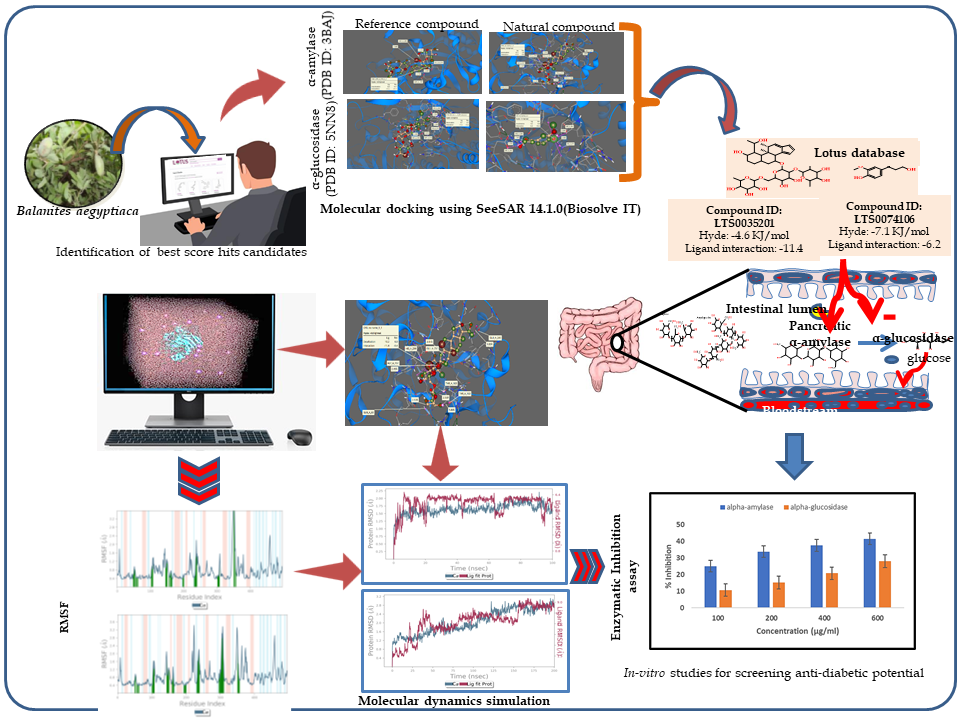The present study investigates the virtual screening of natural compounds from the Ayurvedic medicinal plant Balanites aegyptiaca (BA) using the SeeSAR 14.1.0 tool. Molecular docking was performed using the Lotus database library to screen bioactive phytocompounds against the diabetic targets (α-amylase and β-glucosidase). Molecular docking analysis revealed that two compounds from BA showed strong Hyde binding affinities to the active sites of both enzymes. Furthermore, bioactive compounds were analysed using SeeSAR (Biosolve IT) to predict structural properties, including Lipinski’s rule (ROF), blood-brain barrier permeability, and binding to the highest ligand interactions and receptors. Compounds like LTS0035201 for α-amylase and LTS0074106 for α-glucosidase demonstrated promising inhibitory potential, showing best Hyde docking score and ligand interactions of LTS0035201 -4.6 KJ/mol and -11.4 KJ/mol interacted with residues Glu240, Glu232, His299, Asp197, Thr163 and Gln63 and LTS0074106 (-7.1 KJ/mol) and (-6.2 KJ/mol) interacted with residues of His674, Arg600, Asp282 and Asp404. The protein RMSD values showed that the above 2 Å and ligand RMSD values (6.4 Å). The results revealed that the protein-ligand complex has more stability, as indicated by timescales of 20-40, 50-60, and 80-90 ns. The RMSF values showed that the residue index values fluctuated more with amino acid residues during dynamic simulations, such as 100, 150, 220, 300, and 350. The standard compound showed RMSF values of 100, 150, 200, 220, 300, and 340 for the residue index. The enzyme substrate solution was incubated with varying concentrations of plant extracts, and enzyme activity was evaluated at 540 and 410 nm. Acarbose was utilised as the positive control (60.60 and 7.60 µg/ml). The methanolic extract of BA leaves showed the most significant inhibition activity, with values of 41.41 µg/ml for alpha-amylase and 28 µg/ml for alpha-glucosidase at a concentration of 600 µg/ml. By successfully leveraging plant compounds as therapeutic targets, it may be possible to identify a potent compound for managing diabetes. The results demonstrated the positive biochemical effect of BA extract, which inhibited α-amylase activity.
After 1 year, Surendra Kumar has achieved the following goals:
- SBVS of compounds from Balanites aegyptiaca (BA) was carried out against α-amylase and α-glucosidase, two crucial enzymes involved in the management of diabetes. Molecular docking studies revealed that LTS0035201 and the reference compound displayed the strongest binding affinities, with Hyde scores of -4.6 kJ/mol and -4.0 kJ/mol, respectively, along with ligand interaction values of -11.4 and -10.5 kJ/mol, respectively. Furthermore, LTS0074106 showed a Hyde score of -7.1 kJ/mol, whereas acarbose exhibited a Hyde score of -6.8 kJ/mol, with related ligand interaction scores of -6.2 kJ/mol and -11.5 kJ/mol. These compounds interact with the active site residues Glu240, Glu232, His299, Asp197, Thr163, and Gln63 in AA, as well as Asp404, His674, Asp616, Arg600, and Asp282 in AG, thereby enhancing their ability to inhibit enzyme activity. However, these results reveal that BA compounds have the potential to act as leads for the development of natural treatment of anti-diabetic agents.
- The top-ranked phytocompounds were identified for the respective targets of diabetes. These compounds were explored for MD simulation studies to understand the stability of protein-ligand complexes. The LTS compounds were more stable than the reference compound (acarbose). The protein RMSD values showed that the above 2 Å and ligand RMSD values (6.4 Å). The results revealed that the protein-ligand complex has more stability, as indicated by timescales of 20-40, 50-60, and 80-90 ns. The RMSF values showed that the residue index values fluctuated more with amino acid residues during dynamic simulations, such as 100, 150, 220, 300, and 350. The standard compound showed RMSF values of 100, 150, 200, 220, 300, and 340 for the residue index.
- B. aegyptiaca, which is frequently called Desert date, has been traditionally used for its various pharmacological properties. The present research investigates the effect of BA leaf extract on the activities of α-amylase and α-glucosidase. The enzyme substrate solution was incubated with varying concentrations of plant extracts, and enzyme activity was evaluated at 540 and 410 nm. Acarbose was utilised as the positive control (60.60 and 7.60 µg/ml). The methanolic extract of BA leaves showed the most significant inhibition activity, with values of 41.41 µg/ml for alpha-amylase and 28 µg/ml for alpha-glucosidase at a concentration of 600 µg/ml. By successfully leveraging plant compounds as therapeutic targets, it may be possible to identify a potent compound for managing diabetes. The results demonstrated the positive biochemical effect of BA extract, which inhibited α-amylase activity.





